
Salvia tiliifolia is a vigorous, herbaceous annual in the family Lamiaceae that is native to Central America. As a pioneer of abused areas, the plant has spread in modern times into: South America, as far south as Peru and Bolivia; the southwestern regions of the United States, including the states Texas and Arizona; Africa, including South Africa and Ethiopia; China, including the provinces of Yunnan and Sichuan.
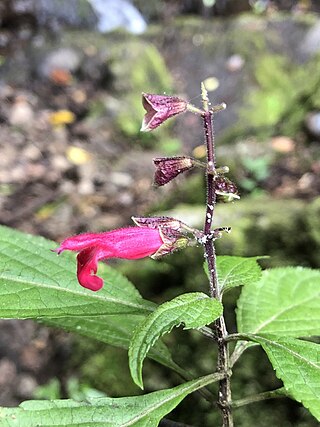
Salvia venulosa is a perennial plant that is native to a very small region of the Western Cordillera in Colombia. It grows at 1,500 to 2,000 m elevation in deeply shaded wooded gullies. S. venulosa grows less than 1 metre (3.3 ft) tall, with narrow ovate leaves that are 6 to 9 cm long and 3 centimetres (1.2 in) wide, and violet on the underside. The flower is an unusual wine-red color.

Salvia rubriflora is a perennial clump forming undershrub endemic to Colombia, growing on exposed grassy banks, near streams, and in dry bushland at elevations from 2,600 to 3,000 m. It is an uncommon plant, most often found at the Cundinamarca-Boyaca border.

Salvia tolimensis is a perennial shrub endemic to a very small region in Colombia (Tolima) growing on streamsides, scrublands, and forest edges in wet conditions at 2,400 to 3,500 m elevation. The plant is a vigorous undershrub, about 1 metre (3.3 ft) high, with narrow ovate leaves that are 6 to 10 cm long and 2.5 to 4 cm wide. The purple flowers are 2.2 to 2.5 cm long.
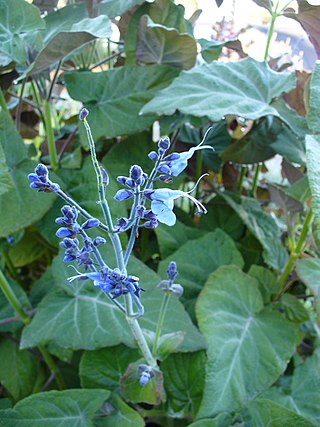
Salvia macrophylla is a perennial undershrub native to Colombia, Peru, and Bolivia. In Colombia it is a rare plant, found growing on roadside banks in the south, at elevations from 1,400 to 2,400 m.
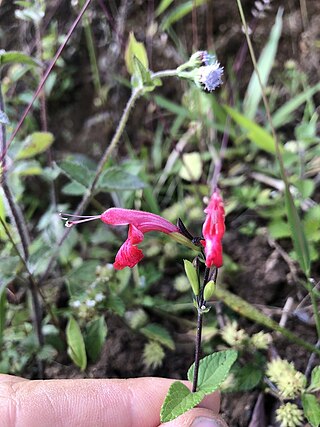
Salvia nubigena is a perennial undershrub endemic to a very small region in the Rio Concavo Valley in Colombia. It if found on rough bushland on boulder covered slopes, growing at elevations from 3,500 to 3,800 m.
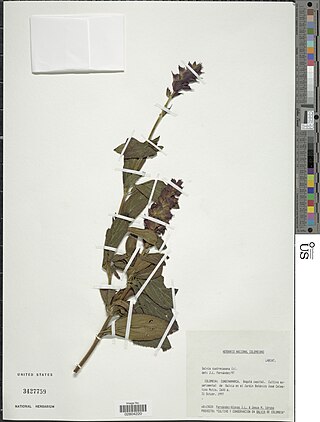
Salvia cuatrecasasiana, first described as Salvia cuatrecasana, is a perennial shrub that is endemic to a few small areas in Colombia, growing at 2,800 to 3,500 m elevation on roadsides, streamsides, and disturbed areas.

Salvia sordida is a rare perennial shrub endemic to a very small area in Colombia, along an old road from Bogota to La Caro, growing at 2,600 m (8,500 ft) elevation in scrub next to streams.
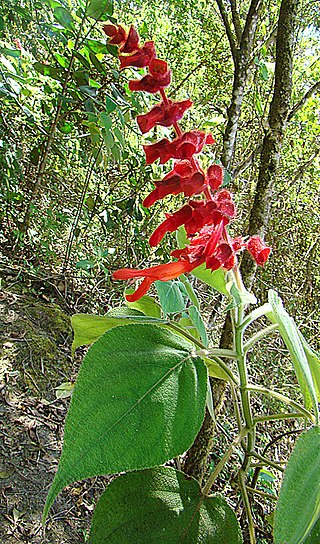
Salvia libanensis is a perennial shrub that is endemic to the northwestern slopes of the Sierra Nevada de Santa Marta in Colombia, growing at elevations between 2,000 to 2,200 m. S. libanensis is a vigorous and spectacular plant reaching 3 m (9.8 ft) tall, with ovate leaves that are 7 to 12 cm long and 3 to 8 cm wide, hairy on both surfaces, with a paler underside. The inflorescence is of terminal racemes, with a 6 cm (2.4 in) red corolla.

Salvia uribei is a herbaceous perennial that is endemic to a single small valley between Tunja and Cucaita in Colombia. It grows in dry scrub, along with Salvia palifolia and Peperomia species, between 2,900 to 2,950 m elevation. It was named after Lorenzo Uribe Uribe, who discovered the plant, and has made significant contributions to Colombian botany.

Salvia macrostachya is a rare herb native to Ecuador and southern Colombia, with no specific information about its native habitat. A woody, clump-forming plant, it grows up to 4 metres (13 ft) high on thick stems, with broadly ovate leaves that are approximately 8 to 12 cm long and wide. The inflorescence is of very dense terminal racemes that are 10 to 30 cm long. The blue corolla is approximately 2.5 cm (0.98 in) in long.

Salvia amethystina is a large aromatic undershrub that is endemic to Colombia. It is found in cloud forests and in bushy ground, often in riparian areas by streams, at 2,500 to 3,500 m elevation. The plant reaches .5 to 1.5 m tall, and sometimes taller, with ovate leaves that are 4 to 12 cm long and 2 to 7 cm wide. The corolla is very large, 1.7 to 3 cm long, and usually blue, rarely purple.

Salvia oxyphora is a herbaceous perennial flowering plant that is endemic to the foothills and lower eastern slopes of the Andes in Bolivia. It is found growing in disturbed rocky slopes above streams in moist subtropical forest at 300 to 2,200 m elevation. It is widespread from the Peruvian border, in the Andean cordillera, to the Santa Cruz area. The plant apparently needs disturbed ground to become established, as it is not found growing in undisturbed areas. In spite of its wide distribution, distinct populations tend to be very small, typically only one to ten plants. Observed plants, both herbarium specimens and wild plants, apparently do not have seeds, possibly due to loss of its native pollinator. For that reason, the wild populations of the plant are vulnerable, though many nurseries carry the plant as of 2012.
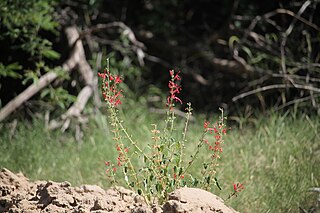
Salvia exserta is an annual herb that is native to the Rio Grande basin in Bolivia, and south into Argentina. It grows in stony ground in dry woodland at 1,300 to 2,700 m elevation.
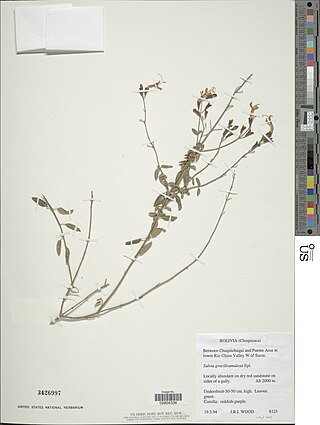
Salvia graciliramulosa is a shrub that is endemic to the Rio Chico valley of Bolivia, growing in red sandstone outcrops at 1,600 to 1,900 m elevation, often growing in colonies on bare slopes.

Salvia grewiifolia is an undershrub that is native to Bolivia and Brazil, growing in open dry forest and clearings.

Salvia orbignaei is an undershrub that is endemic to Bolivia, growing on rocky slopes with other low shrubs at 2,400 to 3,400 metres elevation. It frequently appears following landslides or road building.

Salvia ophiocephala is an annual herb that is endemic to Bolivia—as of 2007 there was only known to be one small colony growing in a Yungas forest valley at 1,200 metres (3,900 ft) elevation. The site is close to settlements and gold-mining, and therefore the plant is considered critically endangered. The specific epithet, ophiocephala, refers to the distinctive teeth in the calyx mouth which hints at the open mouth of a striking rattlesnake. It appears to be related to Salvia personata.
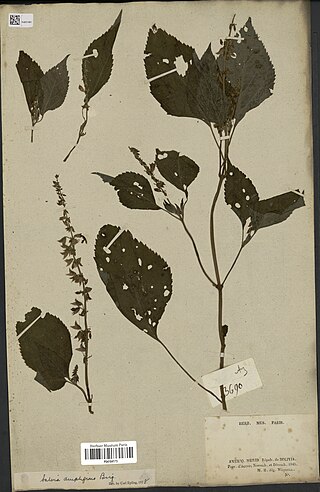
Salvia amplifrons is an annual or short-lived perennial herb that is endemic to Bolivia, growing at 2,650 to 3,000 metres elevation in forest shade on moist ground.

Salvia cardenasii is a rare and endangered perennial herb that is endemic to Bolivia, found in only three small populations, making it vulnerable to grazing animals and other damage. It grows on grassy slopes near rock outcrops, at approximately 3,000 metres (9,800 ft) elevation.




















